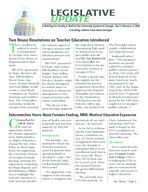LEGISLATIVE UPDATE
A Briefing for Faculty & Staff of the University System of Georgia No. 4, February 4, 2008
"Creating a More Educated Georgia"
Two House Resolutions on Teacher Education Introduced
Two resolutions related to teacher preparation in Georgia were introduced in the House of Representatives last week.
HR 1103, sponsored by Reps. Brooks Coleman, Bill Hembree, David Casas, Jan Jones, Howard Maxwell and Fran Millar, would create a Joint Study Committee on Teacher Training and Certification. The 15-member committee would be charged with assessing
the student impact of Georgia's teacher-education programs, certification process and requirements.
HR 1059, sponsored by Reps. Amy Carter, Bill Hembree, David Knight, Tony Sellier, Tommy Benton and Brooks Coleman, urges the Board of Regents to include more instruction in classroom management in the required teacher-education curriculum.
"The Board of Regents strongly supports
the important mission of preparing high-quality teachers for Georgia's public schools," said Dr. Jan Kettlewell, vice chancellor for P-16 Initiatives for the University System of Georgia (USG).
Nearly a decade ago, the regents set the standard for teacher preparation when they approved the Regents' Principles and Actions for the Preparation of Educators for the Schools, still in use today, she pointed out.
The Principles stress quality, collaboration and responsiveness.
Kettlewell added that, "USG-prepared teachers are greatly valued by Georgia's public school systems." In 2006, 170 of the 180 school districts in the state hired new teachers prepared by the USG, and, at the beginning of the 2005-2006 school year, 77 percent of all new teachers prepared by the USG were employed in Georgia's public schools. Q
Subcommittee Hears About Formula Funding, MRR, Medical Education Expansion
Chancellor Erroll B. Davis Jr. used an appearance before the Senate Appropriations Subcommittee on Higher Education, chaired by Sen. John Wiles, to thank legislators for supporting the University System of Georgia's formula funding, reiterate the importance of funding for Major Repairs and Rehabilitation (MRR) and to highlight the System's intention to both increase produc-
tion of health care professionals and increase capacity by 100,000 students.
Formula Funds
The formula the method by which the System's annual request for general state operating funds is developed tops a list of the System's highest funding priorities, Davis noted.
"We appreciate your support of the formula, which is integral to the
operations of our institutions," he stressed.
As he did in addressing the Joint Appropriations Committee on Jan. 23, Davis reminded legislators that each year, the formula is calculated based on an enrollment total that is two years old. Therefore, the System can be in need, even when the General Assembly grants full formula funding.
"We currently have 270,000 students. As
I have referenced, the Fiscal Year 2009 formula is based on the FY07 enrollment of 260,000 students," the chancellor said.
GGC Update
Davis noted that the System's newest campus, Georgia Gwinnett College (GGC) is helping the USG to carry out its strategic plan to increase both capacity and access to higher education.
See "Davis," Page 2 ...
LEGISLATIVE UPDATE -- February 4, 2008, Issue No. 4
Davis
Continued from Page 1...
"The new funding of $6.5 million will help us meet accreditation requirements such as library holdings," he said. "We expect that Georgia Gwinnett will soon be accepted for candidacy for accreditation by the Southern Association of Colleges and Schools (SACS). This in turn will open the doors to increase enrollment as students become eligible for financial aid."
New Capital Model
Noting that the University System's strategic plan calls for
increasing enrollment capacity by 100,000 students by 2020, the chancellor said, "Clearly we are going to need more facilities to make this possible. Our new capital model gives us a more precise tool to establish our priorities and align them with our strategic plan."
After showing committee members lists of the capital building projects recommended for funding by the Governor, Davis reminded them that MRR funds, which keep the USG's existing facilities usable, are also critical. He expressed appreciation for the Governor's
plan to transition this funding from bonds to cash.
The chancellor noted that the System's MRR request is based on 1 percent of the estimated cost of replacing all of the USG's buildings, adding, "I must point out that the industry standards for MRR are between 2 percent and 3 percent. The MRR needs of our institutions go far beyond our request as least twice as much."
Expansion of Medical Education
The chancellor also outlined the Board of Regents' strategic goal
to increase the production of health-care professionals specifically physicians by increasing the Medical College of Georgia's enrollment capacity from 190 first-year medical students to 300 by 2020.
The $7.2 million recommended by the Governor for FY09 "will help us begin this process," Davis said. Q
-- 2 --
